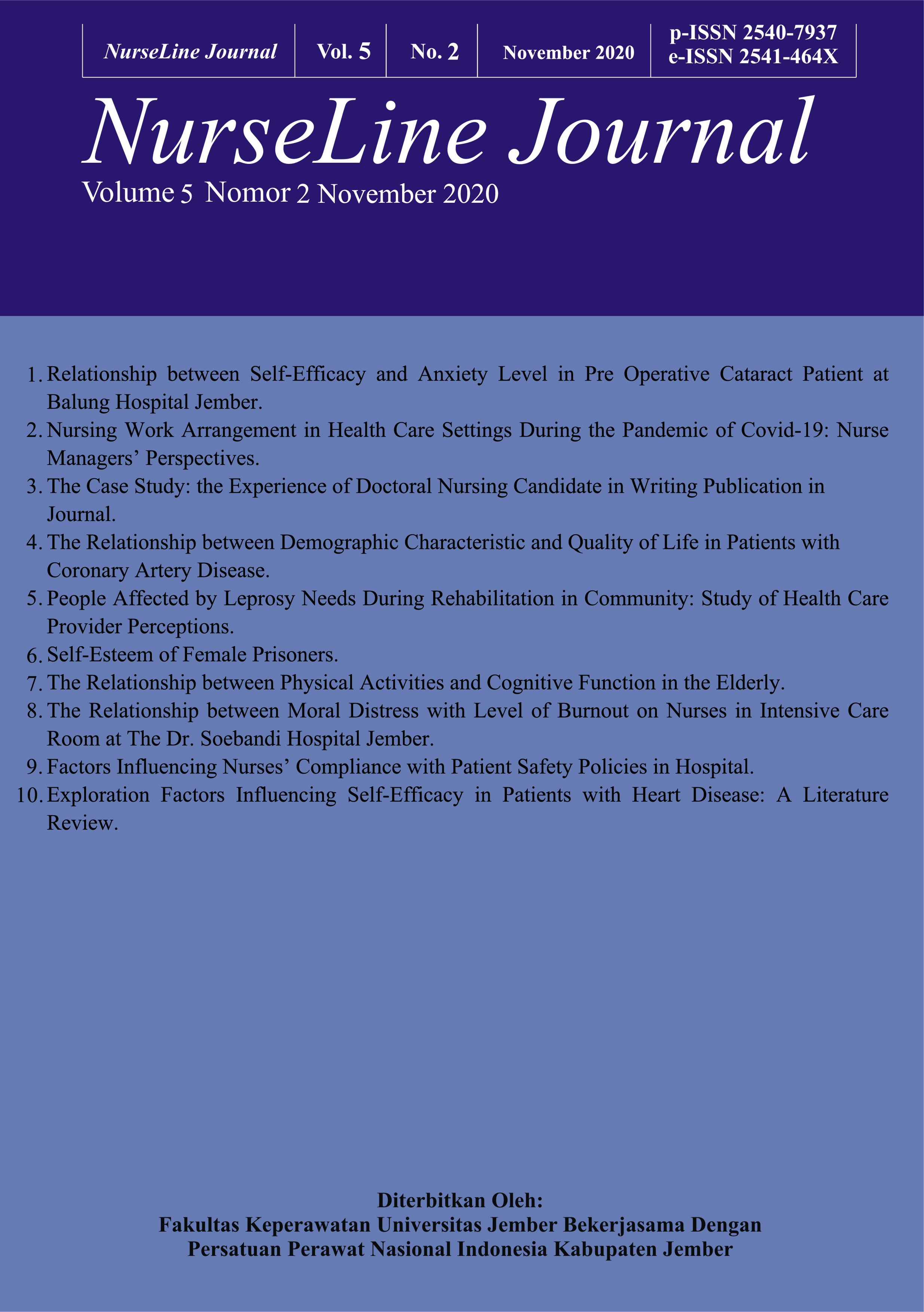People Affected by Leprosy Needs During Rehabilitation in Community: Study of Health Care Provider Perceptions
DOI:
https://doi.org/10.19184/nlj.v5i2.19653Keywords:
People affected by leprosy, Health care providers, Community based rehabilitation, Leprosy, NeedsAbstract
Health care providers (HCPs) in Public Health Center (PHCs) have essential role to fulfil the various complexities of physical, psychological, economic, and social needs among people affected by leprosy (PALs) during treatment in communities. The complexity of these needs is important to prevent the stigmatization and discrimination of PALs for transmission and disability during their rehabilitation. Objective of this study to explore the experience of HCPs for fulfilling the PALs needs during attending community based rehabilitation in PHCs of Jember regency, Indonesia. A descriptive phenomenology was performed to HCPs during July to August 2020. In depth interview was saturated to six of HCPs who were responsibility to care PALs in community. Data was analyzed using systematic coding to all of verbatim of participants. Regarding our in depth interview for sixt of HCPs, we were identified of three of themes which explained into seven of subthemes and sixteen of categories. The main themes were adherence to treatment efforts, treatment to solve social limitation, and caring for preventing disability. The experiences of HCPs in caring for PALs during community based rehabilitation were identified in three main themes, namely: efforts to maintain adherence to treatment, efforts to prevent social barriers, and basic care to prevent disability. Therefore, regular visits through home visits can be carried out on PALs so that MDT compliance is good and reduces side effects. The formation of self-care groups is indispensable in teaching basic care skills in an effort to prevent future disability.
Downloads
References
Chrisnina. 2015. Hubungan Dukungan Keluarga Dengan Interaksi Sosial Pada Klien Kusta di Wilayah Kerja Puskesmas Sumberbaru Kabupaten Jember.Skripsi. Jember : Program Studi Ilmu Keperawatan Jember.
Dadun, D; Van Brakel; W.H, Peters; R.M.H, Lusli; M, Zweekhorst; M.B.M, Irwanto; Bunders aelen, J.G.F;. 2017. Impact of Socio-Economic Development,Contact and Peer Counseling on Stigma Against Person Affected By Leprosy In Cirebon - A Randomised Controlled Trial. Leprosy Review, 88 (1),2-22.
Garbin CAS, Garbin AJÃ, Carloni MEOG, Rovida TAS, Martins RJ. The stigma and prejudice of leprosy: Influence on the human condition. Rev Soc Bras Med Trop 2015;48:194–201. doi:10.1590/0037-8682-0004-2015.
Huzzein Iis; Susanto, Tantut ECR. Hubungan Pemakaian Alat Pelindung DiriTingkat Kecacatan Klien Kusta di Wilayah Kerja Puskesmas Jenggawah dan Tempurejo Kabupaten Jember Tahun 2014 (The Correlation of Application Universal Precaution for Prevent Degree of Disability Clients Lepro. Pustaka Kesehat 2015:89–95.
Kementerian Kesehatan RI. 2012. Pedoman Nasional Program Pengendalian Penyakit Kusta. Jakarta: Dirjen Pengendalian Penyakit dan Penyehatan Lingkungan.
Ministry of Health Indonesia. Pedoman Nasional Program Pengendalian Penyakit Kusta. 1st ed. Jakarta: Kementerian Kesehatan RI; 2012.
Rahayu, D. 2012. Dukungan Psikososial Keluarga Pasien Kusta Di Kabupaten Pekalongan. Tidak Diterbitkan. Hasil penelitian.Semarang :Program Studi Keperawatan Fakultas Ilmu Keperawatan dan Kesehatan Universitas Muhammadiyah Semarang.
Rahayu, N. (2016). Kehidupan Sosial Mantan Penderita Kusta Di Dusun Sumber Glagah Desa TanjungkenongoKecamatan Pacet Kabupaten Mojokerto : Tinjauan Teori Interaksionisme Simbolik george Herbert Mead. Skripsi. Surabaya: Universitas Islam Negeri Sunan Ampel Surabaya.
Susanto T, Sahar J, Permatasari H, Putra SE. Perawatan Klien Kusta di Komunitas. 1st ed. Jakarta: Trans Info Media; 2014.
Susanto T. Pengalaman Klien Dewasa Menjalani Perawatan Kusta Di Wilayah Kerja Puskesmas Jenggawah Kabupaten Jember Jawa Timur: Studi Fenomenologi. Universitas Indonesia, 2010.
Susanto T, Sahar J, Permatasari H. A Phenomenological Study on Leprosy Clients ’ Experience in Having Leprosy Treatment at Jenggawah Public Health Center Area at Jember, East Java, Indonesia. Malaysian J Nurs 2011;3:10–22.
Susanti IA, Mahardita NGP, Alfianto R, Sujana IMIWC, Siswoyo X, Susanto T. Social stigma, adherence to medication and motivation for healing: A cross-sectional study of leprosy patients at Jember Public Health Center, Indonesia. J Taibah Univ Med Sci 2017. doi:10.1016/j.jtumed.2017.06.006.
Susanto T, Dewi EI, Rahmawati I. The experiences of people affected by leprosy who participated in self-care groups in the community: A qualitative study. Lepr Rev 2017;88.
WHO. WHO Technical Advisory Group on Leprosy control 2014:10–1.
WHO. Leprosy: weekly epidemiological record, Septembre 2016. World Heal Organ Wkly Epidemiol Rec 2016;91:405–20. doi:10.1186/1750-9378-2-15.Voir.
WHO. Progress towards the SDGs : A selection of data from World Health Statistics 2018. Geneva: 2018.
WHO. Global Leprosy Strategy 2016-2020. 1st ed. Geneva: WHO; 2016.
Widoyono.D. (2008). Penyakit Tropis : Epidemiologi,Penularan,Pencegahan & Pemberantasannya. Jakarta: Erlangga.








